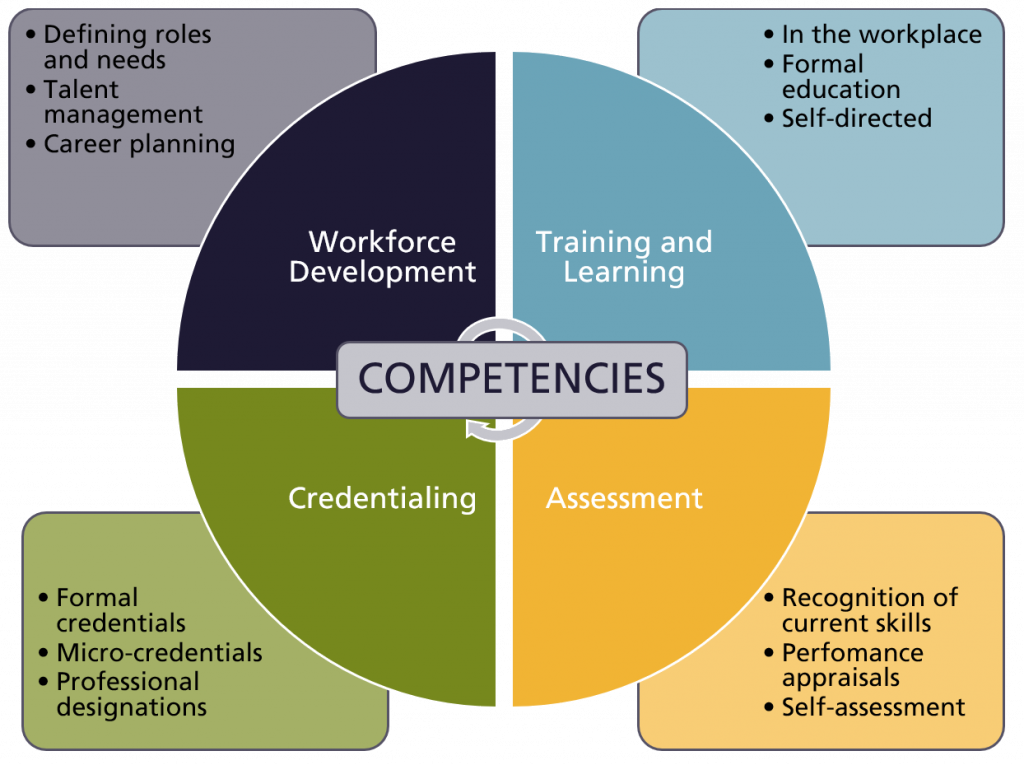7 Uses for competency frameworks
Competency frameworks define the competencies needed to identify, evaluate, and recognize effective performance, typically in the workplace as attached to a job role or occupation. While the range of uses for competency frameworks is wide (some lists include over 100 end uses), there are a few common reasons why a competency framework may be developed, all of which may be applied in either a workplace or an educational context. The language used in each of those settings may vary, but there are four main contexts and primary uses.
| Context |
Use |
| Training and Learning | Developing individuals and teams through teaching and learning activities |
| Assessment | Evaluating individual and team performance in formal and informal ways |
| Credentialing | Recognizing achievements and issuing records of achievement |
| Workforce Development | Identifying individual, organizational and sectoral needs, career planning, and managing talent |
Well-designed competency frameworks support training and learning, assessment, credentialing, and workforce development in different ways. All of these uses are also interrelated, as credentialing and workforce development include some form of training or learning and assessment.

Uses Related to Occupations and Job Roles
Most competency frameworks are connected to occupations and/or job roles in some way. Among frameworks that are built around occupations and job roles, the focus, structure, and use varies greatly, primarily driven by the type of organizations and stakeholders developing and using the framework.
Sector and Professional Organizations
Many competency frameworks are built around an occupation or group of related occupations in an industry sector. They define expected behaviours and performance associated with occupations, as well as outlining career progression between occupations and competencies that are common to many or all of the occupations within the framework. These may form the basis for licensing, continued professional development, specialization, or may link directly to courses and/or certifications issued by the same body that developed and manages the framework. Users of such a framework may include people working in the sector and/or specific occupations; people who are involved in delivering training and certification; and people looking to enter a career in one of the related occupations.
Private Sector Organizations
Larger organizations may have their own competency frameworks, which have been developed specifically for the purposes of workforce planning, performance management, and career progression. These frameworks typically focus less on formal certifications and tie directly into performance review cycles and professional development. Company-wide values or desired attributes often will be defined as core competencies within a framework of this nature. Users of this type of framework would include people in HR, employees and management within the organization, those designing or delivering training for the organization, and job seekers.
Governments and Public Sector
Governments and government organizations use competency frameworks for a range of uses, mostly linked to workforce planning on a macro scale. These frameworks are often broken down by sectors or occupational groups that are national in scope and sometimes tie into national and even international qualification frameworks. These frameworks are used for strategic decision making for things like the education system, career planning by those entering the workforce, and may form the basis for the evaluation of an individual’s skills for the purposes of immigration, skill recognition, or transferability between occupations.
Education
Increasingly, the education system (both in the K-12 and post-secondary contexts) is using competencies and competency frameworks to link educational pathways and outcomes with workforce demands and career paths. Generally speaking, this has been most widely used in connecting existing external competency frameworks to formal learning, rather than developing new competency frameworks. This trend is certainly on the rise in North America and well-established in other jurisdictions that have strong national systems that connect competencies and qualifications.
Other Uses
Educational institutions and/or government bodies (such as Ministries of Education) are also developing high level overarching competencies that are not directly connected to a field of study. These frameworks tend to focus on broad and transferrable competencies that they are looking to develop in all students that will ultimately serve them well long after graduation, regardless of their career path.
The Importance of “Open”
This wide range of uses strengthens the case for competency frameworks to be open and accessible. Competencies span job roles, occupations and sectors, and development cycles for competency frameworks have different drivers. By collaborating and sharing our insights, we make the development and revision of competencies over time easier for everyone and give people the freedom to revisit and revise similar competencies to meet their specific needs and use cases.

